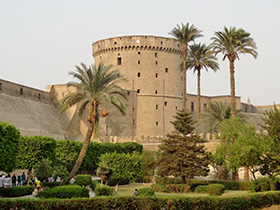Islamic Period and Modern Times Monuments
- Neolithic Period: 4500-3000 BCE
- Early Dynastic: 3000-2650 BCE
- Old Kingdom: 2650-2150 BCE
- 1st Intermediate Period: 2150-2040 BCE
- Middle Kingdom: 2040-1640 BCE
- 2nd Intermediate Period: 1640-1550 BCE
- New Kingdom: 1550-1070 BCE
- 3rd Intermediate Period: 1070-712 BCE
- Saite and Late Periods: 712-332 BCE
- Greco-Roman Period: 332 BCE-642 CE
- Coptic Period: 395-642 CE
- Islamic Period and Modern Times: 642 CE-Today
- Neolithic Period: 4500-3000 BCE
- Early Dynastic: 3000-2650 BCE
- Old Kingdom: 2650-2150 BCE
- 1st Intermediate Period: 2150-2040 BCE
- Middle Kingdom: 2040-1640 BCE
- 2nd Intermediate Period: 1640-1550 BCE
- New Kingdom: 1550-1070 BCE
- 3rd Intermediate Period: 1070-712 BCE
- Saite and Late Periods: 712-332 BCE
- Greco-Roman Period: 332 BCE-642 CE
- Coptic Period: 395-642 CE
- Islamic Period and Modern Times: 642 CE-Today
The Citadel of Cairo
Begun 1176 CE
Ayyubid Dynasty founder Saladin ordered this citadel built in 1176 to unite the cities of Cairo and Fustat, and also to provide a key point of defense against the Crusaders in the capital of his new caliphate. Sitting on a hill overlooking Cairo, the citadel was the seat of government for the rulers of Egypt for over 600 years.
The Citadel of Cairo has undergone numerous renovations and rearrangements over the centuries. The most radical changes began in 1828 when Muhammad Ali Pasha razed some of the existing structures, rearranged the interior, and had his massive, eponymous mosque built.
The citadel’s buildings still dominate the Cairo skyline, and the site is home to three museums today, including one, the Al-Gawhara Palace Museum, commissioned by Muhammad Ali in 1814.

https://archnet.org/sites/218/publications/3165
Rabbat, Nasser O. The Citadel of Cairo – A New Interpretation of Royal Mamluk Architecture. E.J. Brill, Leiden. 1995.

